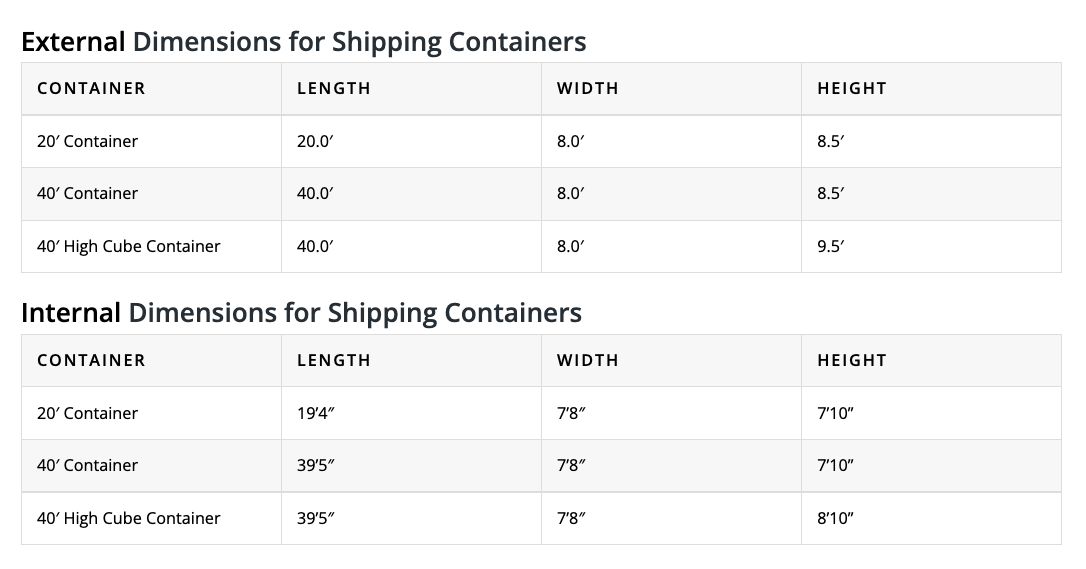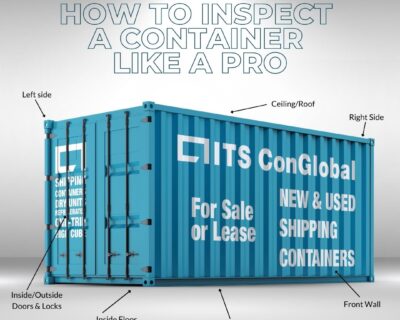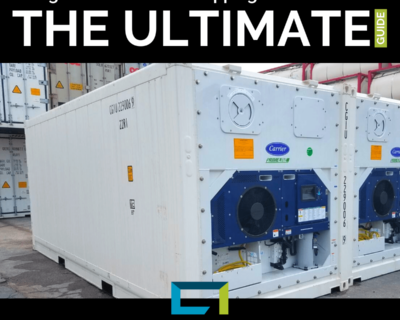News
5-Step Guide to Buying a Shipping Container in 2022

We’ve compiled our top tips and tricks for buying a shipping container like a pro—despite the recent global shipping crisis..
Shipping containers are the lifeblood of world trade. Virtually every product and part circulates through the global economy travels across the seas, railroads, and highways.
Thanks to the pandemic, the humble shipping container has turned into one of the hottest items on the planet. If you are playing around with the thought of buying a shipping container, it won’t take many online searches to figure out the world of containers can be overwhelming.
But don’t let that discourage you. As a leader in the container industry since 1968, we know containers. With strategic locations near ports and inland distribution hubs across the US, Mexico, and Costa Rica, our inventory and access to equipment owners allow us to source containers for consumers, corporations, government, and military institutions.
Below is our 5-step-guide chock full of insider knowledge to help you get the container(s) you want and need for reasonable prices.
Step 1—Find a seller you can trust.
Now and then, buyers can find a good deal on a shipping container from individuals. In some cases, these containers can be in great shape, and because of the motivation to sell, the price may be much lower than a retail option. Whether you are browsing available containers on an online marketplace such as Craigslist, Facebook Marketplace, or eBay, thoroughly inspect the unit before completing the sale. It’s unlikely that the previous owner will take it back if you discover some damage after the sale.
If you live near a major city with a shipping port or rail hub, there may be a variety of ‘retired’ containers that are no longer in the circuit for their primary purpose. Consumers can purchase directly from steamship lines through e-commerce platforms. In most cases, the buyer is responsible for arranging pick up from a designated site within a defined timeline of around seven days.
The advantage of buying a storage container from a national or local container yard or depot is access to a more extensive inventory of equipment, competitive pricing, and top-notch customer service for new, used, or modified containers. Not only will your purchase support local business, but in most cases, you can view your exact container through online photos or in person, so there are no surprises upon delivery. And companies like ITS ConGlobal can arrange delivery within 5-7 days, and we back every box with a guarantee. Find a location near you.
Step 2—Choose the right container for your needs.
If you are in the market for a shipping container, whether for moving, shipping, storage purposes, or something more creative, you may have noticed many options.
Knowing what type of container will fit your needs, literally, will give you a head start in the purchasing process and keep you from struggling with using the box in the future.
Standard containers will be either 20’ or 40’ in length and are 8’6” in height. High Cube containers are also 20’ and 40’ in length but are 9’6” in height. Occasionally 10’, 45’, 48’, and 53’ containers are also available.

The most common container types are 20 ft and 40 ft standard containers, high cubes, reefer or refrigerated containers, units with double or side doors, open-top, hardtop, flat rack containers, insulated containers, or tank containers.
ITSC can special order custom lengths, heights, and door openings. We can help select what container size or type best fits your needs.
Step 3—Accurately assess the container’s condition before buying.
When you’ve figured out which container type is right for you, it’s time to decide which grading and condition you should choose. While there is no universal grading system for shipping containers, shipping companies use the structure and aesthetics of containers to grade and assign abbreviations that explain the overall condition.
- WWT, Wind, and Watertight containers are the most budget-friendly because the well-used container has many dents, scratches, and some surface rust present. The floor will be well worn, and there may be repaired sections. However, they are thoroughly inspected and will keep the wind and water out.
- CW, Cargo Worthy containers are boxes that have been inspected and deemed suitable for international maritime shipping. The container is structurally sound and is clean, with only minor rust or dents on the surface.
- IICL-4, or Premium Grade containers, are graded under strict criteria and bear the Institute of International Container Lessors label. These boxes are structurally sound and will not have issues in the foreseeable future.
- One Trip containers are new containers sold in North America that have only made one trip across the ocean carrying cargo. Containers arrive in near perfect condition with minor dents from loading and transport.
- As is or B-grade containers have no guarantee on their condition, aesthetic, or structural functionality, rust may vary from light to heavy.
Other Grades to be aware of are:
- Grade A – can be a new refurbished or used container
- Grade B – Typically Cargo Worthy
- Grade C – Often wind and weather tight or a rougher appearing cargo worthy container
- Grade F – Food Grade container
Just because a shipping container is ‘used’ doesn’t mean it is in bad condition. Many refer to containers as sea crates or Conex boxes, and they are durable, structurally sound, and designed to withstand harsh conditions while protecting their contents.
Generally, shipping containers spend 10-12 years at sea, and if maintained properly, they can last upwards of 25 years or longer. The lifespan depends on the condition of the container and the environment, and usefulness can be cut short by wetter, saltier climates. You can preserve shipping containers by storing the box off the damp ground so it can’t absorb moisture, removing rust, and keeping the unit primed and properly painted.
ITS ConGlobal performs modifications and repairs in our dedicated shops by highly trained and certified technicians. Maintenance and repair work consists of repairing dents, container floors, leveling container walls, replacing door seals, and patching holes or cracks. Our knowledgeable staff can convert a shipping container to any specification—conversions into homes, office spaces, or commercial spaces. Our modification abilities include adding entry and exit doors, rollup door access, windows or skylights, heating, ventilation, cooling, insulation, electrical lights, outlets, data and phone lines, affixed shelving, and locking mechanisms.
ITS ConGlobal strongly recommends that buyers request condition photos of the exact container or come to one of our container yard/depot locations and inspect it in person. We’ve created an inspection checklist [insert cross link] to help identify warping, corrosion, and other damage that could leave your goods vulnerable to damage or theft.
Step 4—Understanding container pricing and getting the right deal.
Container pricing depends on your choices up to this point—the container type, grading, geographic location, desired modifications, and the cost of delivery. A used container can range between $1,500 and $6,000, whereas new and one-trip containers are usually more expensive, $3,000 to $7,000.
As is the case for most products, storage container prices vary based on supply and demand. The COVID-19 pandemic disrupted supply chains with lockdown regulations, staff shortages, and stranded containers on ships waiting outside ports or within inland hubs, causing a scarcity of shipping containers. Inadequate supply means peak pricing for shipping containers. However, ITS ConGlobal’s expansive network allows us to source, sell, and lease containers at reasonable prices.
Please don’t be shy about shopping around or rejecting a container based on its condition. Our experienced sales team is here to help you get the best quality for your money, and we can provide a detailed quote in 24 hours or less.
Step 5—How to get ready for your shipping container to arrive.
Shipping containers, in most cases, are delivered on tilt-bed-style trucks. These trucks slide the containers off the rear of the trailer. Containers are set on the ground in your predetermined location.
- 20 ft containers need 50-60 ft of straight-line distance to offload the trailer.
- 40 ft containers need 100-120 ft of straight-line clearance.
Before scheduling your delivery, we recommend that you consider:
- Which direction want the cargo doors to face. This decision determines how we load the shipping container onto the trailer.
- Understanding the site conditions will ensure a smooth delivery. We recommend unloading your container onto concrete, asphalt, or dry compacted soil–never soft grass or wet, unlevel surfaces.
- Does the delivery location have obstacles, obstructions, overhanging powerlines, or low hanging limbs? The delivery vehicle is 14 ft tall, and if you must clear the space, you could incur additional delivery fees.
- All deliveries must have a point of contact 18 years or older authorized to sign for the container. The logistics team will call or text on the day of delivery.
Buy shipping containers quickly and easily.
After reading our 5-step-guide to buying a shipping container, it’s not always easy to find the containers you need at the right price in the right location.
But ITS ConGlobal is here to help! Our experienced sales representatives are ready to help you throughout the container-buying process. Find a sales rep near you.


